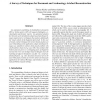Free Online Productivity Tools
i2Speak
i2Symbol
i2OCR
iTex2Img
iWeb2Print
iWeb2Shot
i2Type
iPdf2Split
iPdf2Merge
i2Bopomofo
i2Arabic
i2Style
i2Image
i2PDF
iLatex2Rtf
Sci2ools
112
Voted
ICDAR
2009
IEEE
2009
IEEE
A Survey of Techniques for Document and Archaeology Artefact Reconstruction
An automated assembling of shredded/torn documents (2D) or broken pottery (3D) will support philologists, archaeologists and forensic experts. An automated solution for this task can be divided into shape based matching techniques (apictorial) or techniques that analyze additionally the visual content of the fragments (pictorial). In the case of visual content techniques like texture based analysis are used. Depending on the application, shape matching techniques are suitable for entities of the puzzle problem with small numbers of pieces (e.g. up to 20). Also artefacts like broken and lost pieces or overlapping parts of fragments increase the error rate of shape based techniques since the matching of adjacent boundaries can fail. As a result additional features, e.g. color, document structure, have to be used. This paper presents an overview about current puzzle applications in Cultural Heritage, and introduces also the main problems in puzzle solving.
Document Analysis | ICDAR 2009 | Shape Matching Techniques | Visual Content | Visual Content Techniques |
Related Content
| Added | 21 May 2010 |
| Updated | 21 May 2010 |
| Type | Conference |
| Year | 2009 |
| Where | ICDAR |
| Authors | Florian Kleber, Robert Sablatnig |
Comments (0)

